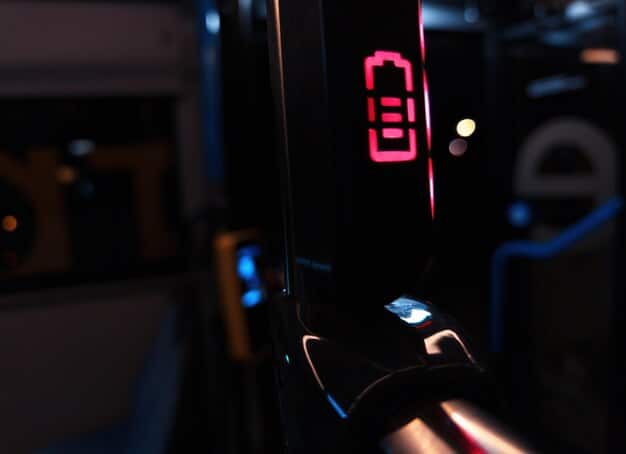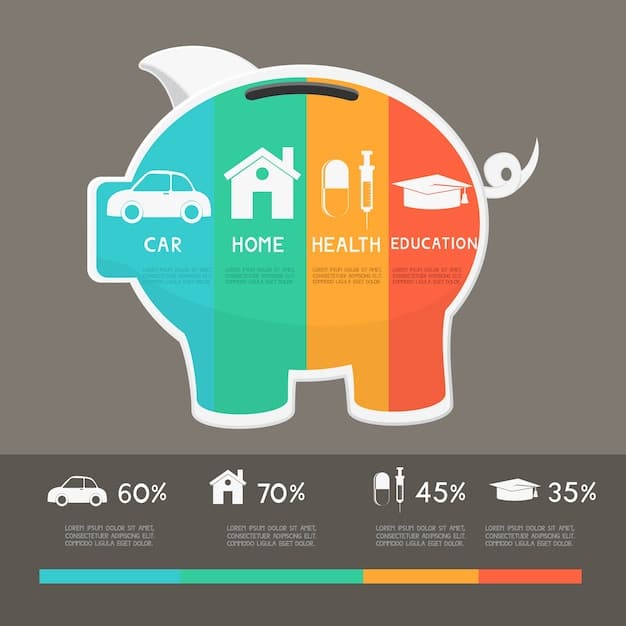The **Tax Credit for Electric Vehicles** offers significant savings, allowing eligible buyers to claim up to $7,500 on qualifying new and used electric vehicles, making eco-friendly transportation more accessible and affordable.
Considering an electric vehicle? The **Tax Credit for Electric Vehicles** can significantly reduce your purchase price, potentially saving you up to $7,500. This guide unravels the complexities of the EV tax credit, helping you determine eligibility and maximize your savings.
Understanding the Electric Vehicle Tax Credit
The Tax Credit for Electric Vehicles, officially known as the Clean Vehicle Credit, is a U.S. government incentive designed to encourage the adoption of electric vehicles (EVs). It aims to lower the upfront cost of EVs, making them more competitive with gasoline-powered cars and promoting a transition to cleaner transportation.
This credit isn’t just for new EVs; it can also apply to used electric vehicles, expanding access to a wider range of consumers. Understanding the specific requirements and eligibility criteria is crucial for taking advantage of this valuable benefit.

Who is Eligible for the EV Tax Credit?
To claim the Tax Credit for Electric Vehicles, both the vehicle and the buyer must meet certain requirements. Let’s break down the key eligibility criteria:
- Income Limitations: The tax credit is subject to income limitations. For those filing single, the modified adjusted gross income (MAGI) cannot exceed $150,000. For those filing jointly, the limit is $300,000, and for heads of households, it’s $225,000.
- Vehicle Requirements: The EV must have a battery capacity of at least 7 kilowatt-hours (kWh) and be manufactured by a qualified manufacturer. The final assembly of the vehicle must also occur in North America.
- Purchase Requirements: The vehicle must be purchased new (or used, in certain cases) for personal use and not for resale.
Meeting these requirements is essential to ensuring you can successfully claim the Tax Credit for Electric Vehicles when filing your taxes.
In conclusion, understanding the eligibility criteria for both the vehicle and the buyer is crucial for leveraging the Electric Vehicle Tax Credit. Meeting income limits, vehicle specifications, and purchase requirements will ensure you can successfully claim the credit.
New vs. Used EV Tax Credits: What’s the Difference?
The Tax Credit for Electric Vehicles extends to both new and used EVs, but there are distinct differences in the credit amounts and eligibility requirements. Knowing these differences is essential for maximizing your savings and making informed decisions when purchasing an EV.
The incentive structure varies based on whether you’re buying a new or used electric vehicle. Below, we’ll clarify the specifics for each.
New EV Tax Credit Details
For new EVs, the tax credit can be up to $7,500, but it’s not a straightforward calculation. The credit amount depends on the vehicle’s battery capacity and whether it meets certain sourcing requirements for battery components and critical minerals.
- Credit Amount Calculation: The base credit is $2,500 for vehicles meeting minimum battery capacity requirements, then increases depending on critical mineral and component sourcing requirements.
- Sourcing Requirements: To receive the full $7,500 credit, a certain percentage of the battery’s critical minerals must be extracted or processed in the U.S. or countries with free trade agreements with the U.S. Similarly, a certain percentage of the battery components must be manufactured or assembled in North America.
- Vehicle Price Caps: New EVs also have price caps to be eligible for the credit. For SUVs, trucks, and vans, the MSRP cannot exceed $80,000. For cars, the limit is $55,000.
Used EV Tax Credit Details
The used EV tax credit offers a maximum credit of $4,000, which is 30% of the sale price, up to the $4,000 limit. This makes electric vehicles more accessible to buyers seeking more affordable options.

- Credit Amount: The credit is equal to 30% of the sale price, up to a maximum of $4,000.
- Vehicle Requirements: The used EV must have a sale price of $25,000 or less, have a model year at least two years prior to the year of sale, and be purchased from a licensed dealer.
- Buyer Requirements: The buyer’s modified adjusted gross income (MAGI) cannot exceed $75,000 for single filers, $150,000 for joint filers, and $112,500 for heads of households.
In summary, the new EV tax credit has a higher potential value but comes with more complex requirements related to battery sourcing and vehicle price caps. The used EV tax credit offers a more straightforward calculation and lower income limits, making it an attractive option for buyers looking for affordable EVs.
Navigating the Fine Print: Key Requirements & Limitations
While the Tax Credit for Electric Vehicles offers substantial savings, it’s important to understand the fine print and potential limitations. Several key requirements can impact your eligibility and the amount of the credit you can claim.
Potential pitfalls exist, so here’s what you need to know to successfully navigate the requirements.
Vehicle Assembly & Sourcing Requirements
One of the most critical requirements is that the final assembly of the EV must occur in North America. This provision, aimed at boosting domestic manufacturing, can exclude certain vehicles from eligibility.
- North American Assembly: Check the Department of Energy’s website for an updated list of vehicles that meet the North American final assembly requirement.
- Battery Sourcing: As mentioned earlier, the percentage of critical minerals and battery components sourced from the U.S. or its free trade partners affects the credit amount. The requirements become stricter over time, so staying updated is essential.
Income and Purchase Restrictions
The Tax Credit for Electric Vehicles also includes income limitations and restrictions on the type of purchase. These factors can significantly impact who can claim the credit.
Certain individuals and purchase types are excluded based on income and intended use.
- Income Limits: As noted previously, your modified adjusted gross income (MAGI) must be below certain thresholds to qualify for the credit.
- Personal Use Requirement: The EV must be purchased for personal use and not for resale. If you plan to use the vehicle primarily for business purposes, different rules may apply.
- No Double Dipping: You cannot claim the Tax Credit for Electric Vehicles if you’ve already claimed another federal incentive for the same vehicle.
In conclusion, navigating the EV tax credit requires careful attention to detail. Understanding the vehicle assembly requirements, income limits, and purchase restrictions will help you avoid potential pitfalls and maximize your savings.
Claiming Your EV Tax Credit: A Step-by-Step Guide
Once you’ve determined that you and your EV meet the eligibility requirements, the next step is to claim the Tax Credit for Electric Vehicles when filing your taxes. The process involves specific forms and documentation.
Successfully claiming the tax credit is straightforward with the correct guidance and preparation.
Gathering Necessary Documentation
Before you start the tax filing process, gather all the necessary documentation related to your EV purchase. This will ensure a smooth and accurate claim.
- Vehicle Identification Number (VIN): You’ll need the VIN of the EV to confirm its eligibility.
- Purchase Date: Have the date you purchased the vehicle readily available.
- Sales Contract: Keep a copy of the sales contract, which includes the purchase price and other relevant details.
Filing the Correct Tax Forms
To claim the Tax Credit for Electric Vehicles, you’ll need to complete specific tax forms and attach them to your federal income tax return. The relevant form varies depending on whether you purchased a new or used EV.
Complete and accurate filing of the forms is essential to receiving the credit.
- Form 8936 (Clean Vehicle Credits): Use this form to claim the new EV tax credit. The form requires information about the vehicle, including its VIN and battery capacity.
- Attach to Form 1040: Include Form 8936 with your Form 1040 (U.S. Individual Income Tax Return) when you file your taxes.
Claiming the EV tax credit involves gathering the right documentation and filling out the appropriate tax forms accurately. By following these steps, you can successfully claim the credit and enjoy the financial benefits of owning an electric vehicle.
Maximizing Your Savings: Tips and Strategies
While the Tax Credit for Electric Vehicles offers a significant financial incentive, there are additional strategies you can employ to maximize your savings when purchasing an EV. These tips can help you reduce the overall cost and make electric vehicle ownership even more affordable.
Strategic planning can enhance your savings beyond the initial tax credit.
Combining Incentives
In many cases, you can combine the federal tax credit with other state and local incentives to further reduce the cost of an EV. Researching available incentives in your area can lead to substantial savings.
- State Rebates: Many states offer rebates for EV purchases, which can be combined with the federal tax credit.
- Utility Company Incentives: Some utility companies offer incentives for installing EV chargers at home, further reducing the cost of EV ownership.
Timing Your Purchase
The timing of your EV purchase can also impact your tax credit eligibility. The availability of certain vehicles and the evolution of sourcing requirements may change over time.
- Year-End Sales: Consider purchasing your EV at the end of the year, when dealerships are more likely to offer discounts to meet sales targets.
- Monitor Updates: Keep an eye on updates to the federal tax credit requirements, as they can change annually.
By combining federal, state, and local incentives, and strategically timing your purchase, you can maximize your savings and make EV ownership even more affordable. Smart planning ensures you get the most benefits available.
The Future of EV Tax Credits: What to Expect
The landscape of Tax Credit for Electric Vehicles is constantly evolving. Changes in legislation, technological advancements, and market dynamics can all impact the availability and structure of EV tax credits in the future.
Staying informed about potential changes will help you make the best decisions for your EV purchase.
Potential Legislative Changes
The federal government may introduce new legislation that modifies the Tax Credit for Electric Vehicles. These changes could affect income limits, vehicle eligibility, and the amount of the credit.
- Monitoring Legislation: Stay informed about proposed bills and regulations related to EV tax credits by following updates from government agencies and industry organizations.
- Advocacy: Consider contacting your elected officials to express your support for EV incentives and policies.
Technological Advancements
Technological advancements in battery technology and manufacturing processes could also impact the future of EV tax credits. As EVs become more affordable and efficient, the need for incentives may decrease.
- Battery Innovation: Keep an eye on developments in battery technology, as they could lead to lower EV prices and increased range.
- Manufacturing Efficiency: Improvements in EV manufacturing processes could make EVs more accessible to a wider range of consumers.
Changes in legislation, technological advancements, and market dynamics can all shape the future of EV tax credits. Staying informed and adapting to these changes will help you make the most of available incentives and embrace the benefits of electric vehicle ownership.
| Key takeaway | Brief description |
|---|---|
| 💰 Max Credit | Up to $7,500 for new EVs, $4,000 for used EVs. |
| 🚗 Vehicle Rules | Must meet assembly, battery, and price requirements. |
| 🧑💼 Income Limits | Income thresholds apply for both new and used credits. |
| 📑 Claiming | Use Form 8936 when filing your taxes. |
Frequently Asked Questions (FAQ)
▼
The maximum tax credit for a new EV is $7,500. This credit depends on the vehicle meeting certain battery capacity and sourcing requirements.
▼
Yes, there are income limitations. For single filers, the MAGI cannot exceed $150,000; for joint filers, it’s $300,000; and for heads of households, it’s $225,000.
▼
Yes, the final assembly of the EV must occur in North America to be eligible for the tax credit. Check the DOE website for qualifying vehicles.
▼
You’ll use Form 8936 (Clean Vehicle Credits) to claim the new EV tax credit. Attach this form to your Form 1040 when filing your taxes.
▼
Yes, you can often combine the federal tax credit with state and local incentives, such as rebates and utility company incentives, to increase your savings.
Conclusion
The Tax Credit for Electric Vehicles presents a significant opportunity to save thousands of dollars on your next car, making the transition to electric mobility more accessible and affordable. By understanding the eligibility requirements, maximizing available incentives, and staying informed about future changes, you can make a smart investment in a cleaner, greener future while saving money in the process.

 PublicTransportAid: Enhance Your Commute Experience Today
PublicTransportAid: Enhance Your Commute Experience Today  Maximize Your Savings: Navigating the Healthcare Benefits Enrollment Period
Maximize Your Savings: Navigating the Healthcare Benefits Enrollment Period  Maximize Your Savings: Navigating the New Healthcare Enrollment
Maximize Your Savings: Navigating the New Healthcare Enrollment